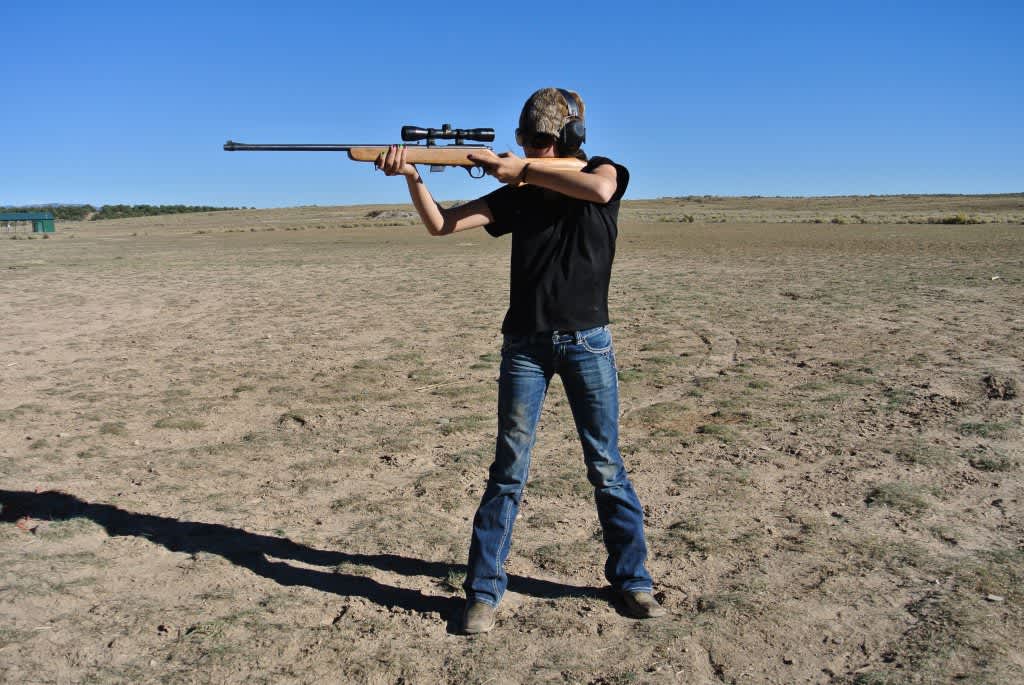The Key to a Successful Hunt: Practice Shooting Positions
Mia Anstine 10.23.12

One cause for a hunter or huntress to not succeed in harvesting their animal is lack of practice. In hunters’ education, they teach us the four basic shooting positions, but it seems when we go to the range we sit at the bench and “sight in”. It is not often that you will find a shooting bench and stool while you are on a New Mexico big game hunt. When you head to the range, practice more than just sighting in your rifle at 100 yards.
Practice the four basic shooting positions. Always remember the rules of shooting safety.
Prone Position
Lying on your stomach, using your arms, bi-pod or pack to support the weight of your rifle, this is the most steady of the basic shooting positions. Practice bringing your rifle to your shoulder and getting your target into your sights. Prone is an excellent position when you are making long distance shots and ideal if you have relatively flat ground and nothing to obstruct your view. In the woods it can be hard to find optimal locations for a prone position. Inevitably you are stalking a bull or a buck and you are in the tall timber or thick scrub oak. There are lots of down trees, rocks and thick grass that may block the view of your target as you lay on your belly. Because of this, you should always practice the other basic shooting positions.
Sitting Position
Sit on the ground with your legs either crossed or apart in front of you creating a triangle (as pictured). Support each elbow on a knee. Pull your position in tight so your arms form a solid support beneath the rifle. In this position a hunter can be accurate at long as well as short distances due to the tri-pod of surface area and anchor points. There is not always time to get down to a seated position. You should practice kneeling and standing positions as well.
Kneeling Position
The kneeling position lacks the solid steadiness of the sitting or prone positions due to the decrease in support of the arms, but this position will be easy to get to in a hurry. Practice dropping to a knee, resting your support arm on the knee and acquiring your sight quickly. With practice you can become steady as well as accurate in this position. It is an important position to practice because sometimes animals come in fast. It will be more steady than the standing position.
Standing Position
The standing position is the least steady so it deserves a lot of practice. In a high pressure situation such as when a bull elk comes running in there may not be time to lie or sit down. This is a magnificent animal so you want to make a good shot. Practice control, acquiring your target in your sights, trigger control and finishing your shot. In a standing position your support arm will be held beneath the rifle and the trigger arm out from your body (as pictured). If you are wavering, move your support arm into your body for added stability. If you are not able to hold steady on your target, do not take the shot.
There are many other devices and objects you can use to support your rifle while in the field. Think about having a mono-pod or bi-pod with you. If you have one, practice shooting with it. Practice sitting, kneeling and standing positions with your shooting sticks. In the field you may be able to use a branch or stump for support. Keep an eye out for things to help you get a good steady shot. Keep in mind the more surface area of your body you have on the ground, the more stable you will be. The more stable you are, the more accurate your shot will be.
Lastly, while you are practicing finishing your shot, practice re-loading. Know the action of your rifle. Quickly lift and jerk the bolt back chambering another round. reacquire your target so you are prepared to shoot again. This is very important in the instance you do not make a good first shot. If you practice good habits at the range, they will show when you are in an exciting position in the field.
Good luck and happy hunting!





